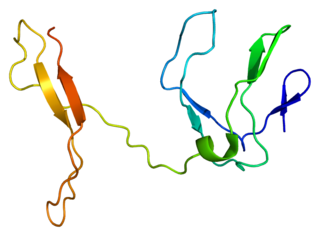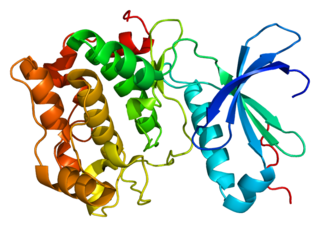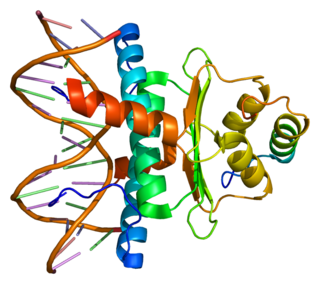Nuclear factor of activated T-cells, cytoplasmic 4 is a protein that in humans is encoded by the NFATC4 gene. [5] [6]
Nuclear factor of activated T-cells, cytoplasmic 4 is a protein that in humans is encoded by the NFATC4 gene. [5] [6]
The product of this gene is a member of the nuclear factors of activated T cells DNA-binding transcription complex. This complex consists of at least two components: a preexisting cytosolic component that translocates to the nucleus upon T cell receptor (TCR) stimulation and an inducible nuclear component. Other members of this family of nuclear factors of activated T cells also participate in the formation of this complex. The product of this gene plays a role in the inducible expression of cytokine genes in T cells, especially in the induction of the IL-2 and IL-4. [6]
NFATC4 has been shown to interact with CREB-binding protein. [7]
In immunology, anergy is a lack of reaction by the body's defense mechanisms to foreign substances, and consists of a direct induction of peripheral lymphocyte tolerance. An individual in a state of anergy often indicates that the immune system is unable to mount a normal immune response against a specific antigen, usually a self-antigen. Lymphocytes are said to be anergic when they fail to respond to their specific antigen. Anergy is one of three processes that induce tolerance, modifying the immune system to prevent self-destruction.

Calcineurin (CaN) is a calcium and calmodulin dependent serine/threonine protein phosphatase. It activates the T cells of the immune system and can be blocked by drugs. Calcineurin activates nuclear factor of activated T cell cytoplasmic (NFATc), a transcription factor, by dephosphorylating it. The activated NFATc is then translocated into the nucleus, where it upregulates the expression of interleukin 2 (IL-2), which, in turn, stimulates the growth and differentiation of the T cell response. Calcineurin is the target of a class of drugs called calcineurin inhibitors, which include ciclosporin, voclosporin, pimecrolimus and tacrolimus.
Nuclear factor of activated T-cells (NFAT) is a family of transcription factors shown to be important in immune response. One or more members of the NFAT family is expressed in most cells of the immune system. NFAT is also involved in the development of cardiac, skeletal muscle, and nervous systems. NFAT was first discovered as an activator for the transcription of IL-2 in T cells but has since been found to play an important role in regulating many more body systems. NFAT transcription factors are involved in many normal body processes as well as in development of several diseases, such as inflammatory bowel diseases and several types of cancer. NFAT is also being investigated as a drug target for several different disorders.

Nuclear factor NF-kappa-B p105 subunit is a protein that in humans is encoded by the NFKB1 gene.

Transcription factor RelB is a protein that in humans is encoded by the RELB gene.

Nuclear factor of activated T-cells, cytoplasmic 2 is a protein that in humans is encoded by the NFATC2 gene.

Nuclear factor of activated T-cells, cytoplasmic 1 is a protein that in humans is encoded by the NFATC1 gene.

Protein kinase C theta (PKC-θ) is an enzyme that in humans is encoded by the PRKCQ gene. PKC-θ, a member of serine/threonine kinases, is mainly expressed in hematopoietic cells with high levels in platelets and T lymphocytes, where plays a role in signal transduction. Different subpopulations of T cells vary in their requirements of PKC-θ, therefore PKC-θ is considered as a potential target for inhibitors in the context of immunotherapy.

Mitogen-activated protein kinase kinase kinase 14 also known as NF-kappa-B-inducing kinase (NIK) is an enzyme that in humans is encoded by the MAP3K14 gene.

Nuclear factor of activated T-cells 5, also known as NFAT5 and sometimes TonEBP, is a human gene that encodes a transcription factor that regulates the expression of genes involved in the osmotic stress.

AP-1 complex subunit beta-1 is a protein that in humans is encoded by the AP1B1 gene.

Nuclear factor of activated T-cells, cytoplasmic 3 is a protein that in humans is encoded by the NFATC3 gene.

Calcineurin subunit B type 1 also known as protein phosphatase 2B regulatory subunit 1 is a protein that in humans is encoded by the PPP3R1 gene.

Calcineurin-binding protein cabin-1 is a protein that in humans is encoded by the CABIN1 gene.

Calcium modulating ligand, also known as calcium-modulating cyclophilin ligand, is a signalling protein recognized by the TNF receptor TACI.

Mitogen-activated protein kinase 4 is an enzyme that in humans is encoded by the MAPK4 gene.

Serine/threonine-protein phosphatase 2B catalytic subunit alpha isoform (PP2BA) is a protein that in humans is encoded by the PPP3CA gene.
Gerald R. Crabtree is the David Korn Professor at Stanford University and an Investigator in the Howard Hughes Medical Institute. He is known for defining the Ca2+-calcineurin-NFAT signaling pathway, pioneering the development of synthetic ligands for regulation of biologic processes and discovering chromatin regulatory mechanisms involved in cancer and brain development. He is a founder of Ariad Pharmaceuticals, Amplyx Pharmaceuticals, and Foghorn Therapeutics.

NFAT activating protein with ITAM motif 1 is a protein that in humans is encoded by the NFAM1 gene.

NFAT activating protein with ITAM motif 1 is a protein that in humans is encoded by the NFAM1 gene.
This article incorporates text from the United States National Library of Medicine, which is in the public domain.